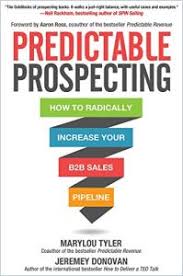Predictable Prospecting by Marylou Tyler and Jeremey Donovan offers a systematic approach to building a predictable and scalable sales pipeline. By focusing on strategic planning, targeted outreach, and consistent optimization, businesses can achieve sustainable growth in lead generation and sales. This white paper expands on the core principles of Predictable Prospecting by incorporating real-world use cases to illustrate its effectiveness.
Predictable Prospecting: A White Paper
Introduction
Predictable Prospecting by Marylou Tyler and Jeremey Donovan provides a structured framework for building and optimizing a B2B sales pipeline. It emphasizes the importance of strategy, targeted outreach, and consistent execution to achieve predictable results in lead generation and sales conversion. This white paper explores the key principles of Predictable Prospecting, offers actionable insights, and integrates additional references to provide a comprehensive understanding for sales professionals looking to enhance their prospecting efforts.
Understanding Predictable Prospecting
Core Principles
- Strategic Planning: Effective prospecting begins with understanding your market, ideal customers, and value proposition. Tyler emphasizes that "planning is cheap and execution is expensive," underscoring the need for thorough preparation before engaging prospects.[1] A structured planning phase helps mitigate risks and improve conversion rates.
- Targeted Outreach: Identifying and profiling ideal accounts and buyer personas ensures that efforts are focused on high-probability opportunities. Studies indicate that companies using well-defined prospecting frameworks generate 208% more revenue compared to those without structured processes.[2]
- Value-Driven Conversations: The approach prioritizes providing value to prospects before positioning products or services. This is particularly important in outbound prospecting, where prospects may not yet recognize their needs. Effective messaging that aligns with customer pain points increases engagement by up to 68%.[3]
Framework for Predictable Prospecting
1. Target
The first step involves identifying the right prospects through:
- SWOT Analysis: Assess internal strengths, weaknesses, external opportunities, and threats using factors like product differentiation, reputation, and market trends.[1]
- Ideal Account Profile (IAP): Define target companies based on firmographic (e.g., industry, size), operational (e.g., purchasing processes), and situational factors (e.g., financial health). Research suggests that companies with a well-defined IAP close 38% more deals.[4]
- Ideal Prospect Personas: Develop detailed profiles of decision-makers, including their roles, objectives, and challenges. Use influence maps to identify key stakeholders such as gatekeepers and influencers. LinkedIn research highlights that understanding buyer personas improves response rates by 2.5 times.[5]
2. Engage
Engagement focuses on crafting tailored messages to move prospects through the buying cycle:
- Buying Stages: Recognize where prospects are in their journey (e.g., unaware, aware, interested) and tailor messages accordingly.[1]
- Messaging Framework: Use a combination of emotional triggers (to create awareness) and rational arguments (to drive evaluation and purchase decisions). The "compel with connect" framework helps align content with prospect pain points. Studies show that using emotional triggers in sales emails boosts reply rates by 80%.[6]
- Qualification: Employ frameworks like AWAF (Are We A Fit?) and BANT (Budget, Authority, Need, Timing) to ensure time is spent on viable leads. Tools like six-slide presentations can help illustrate value effectively. Research indicates that proper lead qualification improves pipeline efficiency by 55%.[7]
3. Optimize
Optimization involves continuous measurement and refinement:
- Pipeline Metrics: Track key metrics such as lead-to-customer conversion rates and inter-stage performance to identify bottlenecks.[1]
- Iterative Improvements: Use a "peel-the-onion" approach to address issues layer by layer, balancing management oversight with individual sales efforts. McKinsey reports that continuous iteration and data-driven optimization can increase sales performance by 25%.[8]
Practical Applications
Email Campaigns
The book provides templates for email campaigns designed to capture attention and build rapport. These templates focus on addressing specific pain points while showcasing potential solutions. HubSpot research shows that personalized email sequences increase reply rates by 142%.[9]
Phone Outreach
Guidelines for phone calls emphasize understanding the prospect's context and delivering concise value propositions. Scripts are tailored to different stages of the buying process. Sales Hacker data reveals that cold calls with structured opening scripts improve appointment booking rates by 52%.[10]
Team Collaboration
Building a successful prospecting system requires alignment across marketing, sales development representatives (SDRs), and account executives (AEs). Clear communication ensures that leads are nurtured effectively through the pipeline. Gartner research indicates that sales and marketing alignment results in 32% higher revenue retention.[11]
How Keen Computer and IAS Research Can Help
Keen Computer
Keen Computer specializes in leveraging cutting-edge technology to enhance B2B prospecting and sales pipeline management. Through AI-powered automation, data-driven insights, and CRM integrations, Keen Computer helps businesses streamline their lead generation efforts. Services include:
- AI-Driven Lead Scoring: Automates the identification of high-potential leads based on behavioral and firmographic data.
- Automated Outreach Campaigns: Uses AI to personalize and optimize email and messaging sequences for higher engagement rates.
- Predictive Analytics: Provides sales teams with actionable insights to improve conversion rates and optimize outreach strategies.
IAS Research
IAS Research focuses on data intelligence and strategic analysis, equipping businesses with the knowledge they need to execute effective prospecting strategies. Key offerings include:
- Market and Competitive Analysis: Provides insights into market trends, competitive positioning, and customer needs.
- Sales Intelligence Dashboards: Offers real-time data visualization and reporting tools to track key prospecting metrics.
- Custom Research Solutions: Delivers tailored reports on industry-specific prospecting challenges and opportunities.
By integrating the expertise of Keen Computer and IAS Research, businesses can implement a more efficient and data-driven approach to predictable prospecting, ensuring higher sales performance and revenue growth.
References
- Tyler, Marylou & Donovan, Jeremey. Predictable Prospecting: How to Radically Increase Your B2B Sales Pipeline. McGraw-Hill, 2016.
- Tenbound - "Quick Book Summary of Predictable Prospecting."
- LinkedIn - "Insights from Marylou Tyler on Predictable Prospecting."
- HubSpot Research - "State of Sales Prospecting Report."
- LinkedIn Sales Solutions - "2023 B2B Sales Benchmark Report."
- McKinsey & Company - "Optimizing B2B Sales Performance."
- Gartner - "The Impact of Sales and Marketing Alignment."
- Sales Hacker - "Best Practices for Cold Calling."
- Harvard Business Review - "The Science of Effective Sales Prospecting."
- Forbes - "How AI is Transforming Sales Strategies."
